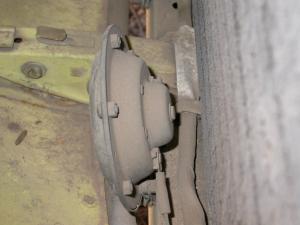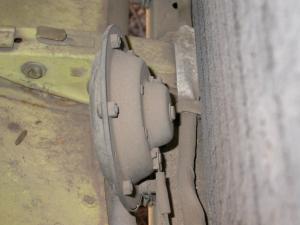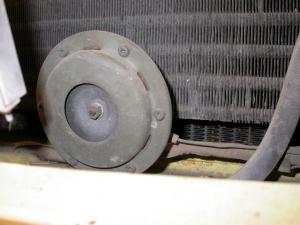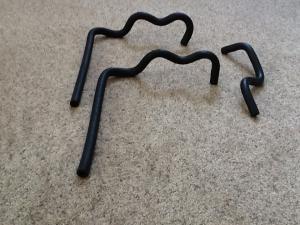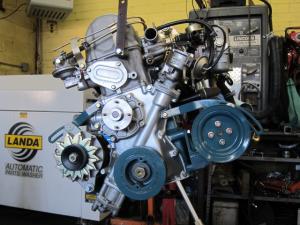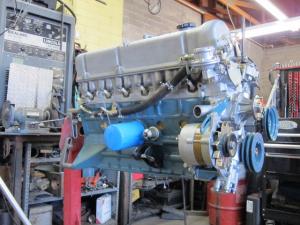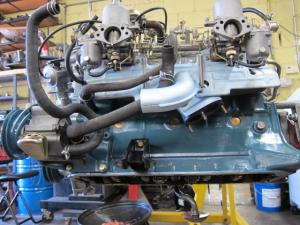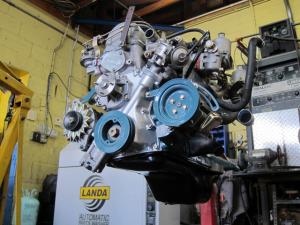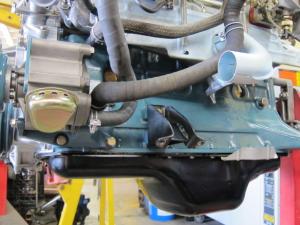Everything posted by AZ-240z
-
Panel Alignment
Mike, thanks for the great supporting pictures. Like I said, this old guy is just as sharp as ever, chuckle, chuckle! Is that my decal you have on your master vac, Mike, or is it the original one? Dan
-
Panel Alignment
I'm going to try and fumble my way through this explanation, so bear with me. The top cowl is refered to as the "grill-cowl top". The struction under this is called the "assy- cowl top outer". This "assy-cowl top outer" has a couple of landings, for need of a better term, one at each end on which the "grill-cowl top" rests. It's been many years since I first removed the original "grill-cowl top" when a tree branch fell on it and needed to be replaced. As I recall, those landings each had a ,probably, closed cell hard foam rubber pad attached for the "grill-cowl top" to rest on. I couldn't tell you the thickness of these pads but they were probably about 1/4 to 3/8 inchs thick. I got the terminology used in this explanation from the club "Z-Car CD ROM". I'm hoping that there are others who can help either confirm or refute my recall on this, so please chime in. If you don't have these pads for your cowl to rest on, this may explain why your cowl sits slightly lower than your fenders. Let me know what you think. Dan
-
Cataloging 240z factory manufacture paint marks
Good pictures, Chris! Especially the "Gigglishous" oil pan overspray.
-
Cataloging 240z factory manufacture paint marks
I think "Blue's" answers are exactly correct concerning the assembly line marks. This is just my opinion, but I would say that the original oil pan color Is about 80% gloss black. In contrast, the gas tank was close to 100% gloss black. I thought about trying to duplicate the blue engine overspray, but I couldn't find enough pictorial evidence showing The correct locations of overspray to determine how it was possibly applied. Dan
-
Cataloging 240z factory manufacture paint marks
Thanks, Mike. More good examples to archive. As demonstrated in your pictures, the challenge will not only mark the correct locations, but to emulate the technique used. The daubs of paint were applied in a purposeful, yet timely manner with attention to neatness secondary as the car traveled down the assembly line. Dan
-
Cataloging 240z factory manufacture paint marks
Blue, more great pictures. Much appreciated. I spent time on this board a number of years ago defining the paint marks on springs with member Carl Beck. Carl had, through Courtesy Nissan, arranged for the reproduction of a number of set of springs and your pictures reinforce what Carl had found as to the correct paint marks. Dan
-
Cataloging 240z factory manufacture paint marks
Chris, thanks for the pics of both your car and a car done by Mike McGinnis. I have talked with Mike (caught him at a busytime under a car) and asked him if he had mapped out all of these yellow production marks. I'll get back to him on any specific marks when he has more time, but he did indicate there were variations as to the location of these yellow marks with no definitive mapping. Your pictures are very important as they not only convey the location, but how they were applied with obvious disregard as to neatness. The smear of paint likely not only hit the targeted fastener, but also surrounding structures. Dan
-
Cataloging 240z factory manufacture paint marks
I've been trying to gather picture data of the original factory paint marks used during the assembly process. Using the search function, i guess I may not be identifying correctly what I am looking for. Has anyone mapped out all of the yellow splotches of paint used during the assembly of a 240z, or have pictures of survivor cars which depict the location of said yellow assembly marks? Thanks for any help from a helplessly addicted originality GEEK!
-
How I refinished the horns in my '73 240Z
Jim, I have contacted Nikkibid on behalf of this discussion as I had previously purchased this horn kit from him. He said he no longer offers this hardware and gasket kit. He frequently offers products on eBay and I highly recommend him and whatever he sells. Dan
-
How I refinished the horns in my '73 240Z
-
How I refinished the horns in my '73 240Z
Here is another picture that shows the back of the horn. Granted, it is difficult to tell if the finish is natural, but I have seen many other survivors that had a natural rear cover.
-
How I refinished the horns in my '73 240Z
There have been many thoughts on what is factory correct for refinishing our horns. I have attached a picture of an early 1970 Z horn to support what I feel is correct when talking about "how it came from the factory"/ 1. Front cover is olive drab. 2, Center diaphragm is satin black 3. Center bolt and nut clear zinc. 4. outer mounting screws, front side, olive drab. 5. rear cover and nuts are natural finish. 6. mounting brackets are natural finish. 7. 4 large mounting machine screws and washers are yellow zinc. I may know of someone who offers a kit of gaskets and screws, nuts, and washers for rebuilds. Dan
-
Subscriptions? Hello Mike...
Mike, Bueller, anyone, Bueller, Anyone, Can anyone tell me why I can't view new content?
-
Carburetor Air Cleaner and Fuel Pump Parts
http://www.classiczcars.com/topic/50679-rebuilding-the-nikki-fuel-pump/
-
Sealing an oil pan
Something that is probably obvious to everyone, but occasionally overlooked is, when you have the oil pan in hand, make sure that the mounting flange is as flat as possible. I have been guilty of over-tightening the oil pan mounting screws in the past which will definitely deform that flange and make leaks highly probable. Just my two cents. Dan
-
Hardway's 1971 240z #8011 - Build and Repair Thread
Just to add to my last post, and I thought that this would be the most logical place for this, I wanted to see how difficult it would be to make a full set of these hoses using my technique. I did make a pretty nice set with the correct 11/32" ID brake vacuum hose and 1/4" copper tubing. I first formed the copper tubing, and then, with some sil-glide lube, threaded to hose over the tubing. In retrospect, I probably wouldn't compete the copper tubing bends, just start them so as to make getting the hose on a little easier. I have attached an image of the hoses with the ones I made in the foreground and to the right. The vac side hose in the back of the image is an NOS rubber vac hose I used to replicate. I trial fitted both hoses to my car and the fit was perfect, as far as I could tell. My experiment successfully completed, I am offering these to anyone in need of a set of early mastervac hoses for the cost of mailing. Please PM me with your response, and I hope that this may help others on this forum. Dan
-
E88 head in a Series 1 car?
http://ZHome.com/ZCM...andE88Heads.htm
-
Hardway's 1971 240z #8011 - Build and Repair Thread
The process I used to create this master vac hose section is something I learned from Kats. Kats used braided fuel hose which is the exact correct size, but much softer than rubber vacuum tubing, and brass rod to give the hose perminent shape. I used 11/32" ID brake vacuum hose from NAPA AUTO PARTS which is an exact match in size and texture to the Nissan hose, and 1/4" copper refrigerant tubing from Home Depot. Using a length of the copper tubing, I shaped it first and then slid the rubber hose over the tubing. A little sil-glyde on the tubing made the process fairly smooth but guard against using excessive pressure that might kink the copper tubing. Before inserting the copper tubing, you must cut enough off of each end of the copper tubing, one to one and a half inches, to allow room for the master vac, check valve, or engine mounting fitting in the rubber tubing. I, also, leave an extra 1/2" or so on the rubber tubing that can later be trimmed for a perfect fit. I plan to make a compete set of these master vac hoses and will take all the measurments for those who might want to try this for there own project. I'll try to attach the reference to Kats posting. http://www.classiczcars.com/topic/23900-datsun-240z-vs-fairlady-z432/page-8 Look at post #154 on this page. Let me know if there are any questions as to how I made this hose. And, yes, the copper tubing remains in the vacuum hose to maintain the shape. Dan
-
Early 240Z (HLS30) parts spreadsheet
Mike B, Is this spreadsheet still available? I'm unable to access it with the above address. Dan
-
Alternative Brake Vacuum Hose Source?
I believe that the booster side hoses are all the same up to 6/72. As for the balance tube, or engine side hose, as Marty mentioned, some balance tubes had an optional plug on the top of the balance tube as well as the end. If your balance tube has this optional plug on top, and you wanted to move the location of your engine side hose to accomodate the hose I have, then my hose would work. As your cars build date is 8/70 which is approximately the model year change-over date from '70 to '71, this is most likely the change-over for this hose configuration. If you are concerned about originality, there is a general consensus that parts usage became blurred as to what was correct during model changes, but this would be your call. Dan This is a reference for dates from our parts CD. D:\ZCD\BASEQ3\PAK\YODA\S30_5c.pdf
-
Alternative Brake Vacuum Hose Source?
Hardway, from the pictures in your signature thread, it looks like your engine side master vac hose is the early style that plugs into the end, rather than the top, of the balance tube, correct? I may be able to help you out on the master vac side hose, and the engine side hose, only if it plugged into the top of your balance tube. What I have are lightly used rubber style OEM hoses that are in new condition, except for the clamp impressions. PM me if interested. Dan
-
Correct Series 1 Valve Cover and Air Cleaner for my Z
Here are a few pictures of my engine while I was preparing it for the 2012 Convention that shows the exhaust manifold heat riser.
-
Correct air cleaner for series one?
And, here are some pictures of my engine which shows the exhaust manifold heat riser attached.
- cut pile or fluffy?
-
Correct Series 1 Valve Cover and Air Cleaner for my Z
Here is a discussion I was able to find that may be of help. http://www.classiczcars.com/topic/30810-correct-air-cleaner-for-series-one/?hl=%2Bcleaner+%2Bhousing#entry289842 From what I have learned in the past, August of 1970 was the model changeover between the 1970 & 71 modl years. Smog laws required the addition of carb pre-heat starting in 1971. As you can see from your picture, there are two bosses cast into your exhaust manifold just above the exhaust pipe mating flange. Those bosses would have threaded holes to accomodate the exhaust carb heat riser cover if your car had the air cleaner snorkel for a flex tube connecting the air cleaner to the exhaust manifold heat riser cover. Since there are no threaded holes in the exhaust manifold hosses, your car did not have the air cleaner with snorkel for carb pre-heater. I also associate the model changeover month wih the valve cover change from "Nissan 2400" to "Nissan OHC" covers. This and other model year changes can be flexible due to the availability of parts at the time of manufacture. Again, these are just my opinions from research I have done for the restoration o my car. Hope it helps. Dan







